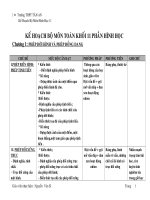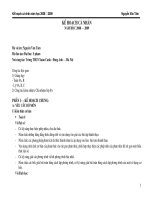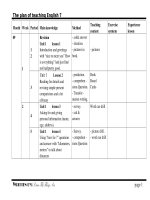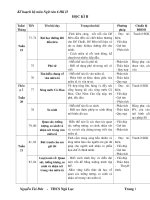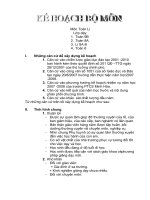Kế hoạch bộ môn TA 6
Bạn đang xem bản rút gọn của tài liệu. Xem và tải ngay bản đầy đủ của tài liệu tại đây (67.06 KB, 12 trang )
kế hoạch bộ môn tiếng anh lớp 6
I. đặc điểm tình hình
1. Yêu cầu của bộ môn
- Nội dung chơng trình SGK tiếng Anh 6 đợc xây dựng nhằm cung cấp cho học sinh những kiến thức cơ bản về ngữ âm, ngữ
pháp, từ vựng và văn bản.
- Nh vậy sau khi học môn tiếng anh 6 học sinh đạt đợc những yêu cầu sau:
+ Nắm đợc kiến thức cơ bản tối thiểu và tơng đối hệ thống về tiếng Anh thực hành hiện đại, phù hợp với lứa tuổi
+ Có kĩ năng cơ bản sử dụng tiếng Anh nh một công cụ giao tiếp đơn giản dới dạng: Nghe- Nói- Đọc- Viết
+ Có sự hiểu biết khái quát về văn hóa các nớc sử dụng tiếng Anh
+ Hình thành các kĩ năng học tiếng và phát triển t duy.
2. Thực tế giảng dạy của giáo viên
- Giáo viên đã quen với phơng pháp giảng dạy theo phơng pháp mới và có nhiều tiến bộ đổi mới so với năm trớc
3. Thực tế học sinh năm học trớc
- Năm học trớc ở trờng Tiểu học, học sinh đã đợc làm quen với bộ môn tiếng Anh
- Cha đợc làm quen với phơng pháp mới của chơng trình THCS
4. Tình hình học sinh hiện nay
- Tuy các em đã làm quen với bộ môn Tiếng Anh, song vẫn còn bỡ ngỡ khi tiếp cận cái mới.
5. Điều kiện thực hiện bộ môn này
a. Cơ sở vật chất
- Có đầy đủ phòng học bộ môn
- Có phòng nghe nhìn.
b. Sách tham khảo
- Có đủ SGK, sách giáo viên và sách tham khảo
c. Thiết bị dạy học
- Phải có đủ băng đài, tranh ảnh minh họa.
II. Biện pháp thực hiện
1. Đối với giáo viên
- Giáo viên phải có đủ trình độ dạy học theo chơng trình SGK tiếng Anh mới
- Phải đợc bồi dỡng thờng xuyên để nâng cao trình độ chuyên môn nghiệp vụ cũng nh phơng pháp giảng dạy để có thể thực
hiện chơng trình một cách linh hoạt, sáng tạo, hiệu quả và phù hợp với từng đối tợng học sinh.
- Dành nhiều thời gian cho soạn bài và nghiên cứu tài liệu
2. Đối với học sinh
- Tham gia luyện tập thực hành giao tiếp, mạnh dạn tích cực và có chủ định, có hiểu biết về ngôn ngữ khi luyện tập, có hiểu
biết về quy trình học tập và có phơng pháp học tập cá nhân
- Kết hợp tốt các hoạt động học tập và làm bài tập về nhà
III. KÕ ho¹ch cô thÓ
Units,
periods
Contents of the lessons The aims Main
methods
Teaching
aids
Note
TiÕt 1
Unit 1
Greeting
(TiÕt 2->6)
Unit 2
At school
(TiÕt 7->12)
Consolidation
- Hello/ Hi. "I'm.../ My name...." to introduce
yourself.
- How are you? I'm fine, thanks. To greet each
other.
- "Good morning/ afternoon/ evening" to greet each
other. "We're...." to talk about age and contrast with
us.
- "How old are you? " to talk about age...
- Further practice in numbers from 1 to 20 to count
and give telephone numbers.
- Classroom, imperative to understand the teacher's
commands
-"Where do you live? question & answer you live.
- "What's your name?" and "How do you spell it?"
with the Alphabet to talk about your name.
- Further practice in personal information, alphabet
and numbers.
- This/ that, positive statements and "Yes/no"
questions to talk about people and things at school.
- Greet people
- Identify
oneself
- Ask how
people are
- Say goodbye
- Introduce
oneself and
others
- Say how old
one/others
is/are.
- Count to 20
- Give and
obey orders
- Ask for and
give personal
information
- Identify
oneself and
others
- Identify
- Teacher
<-> whole
class
- Group
work
- Pair
work
Individual
- Teacher
<-> whole
class
- Group
work
- Pair
work
Individual
- Text
book
- Pictures
- Poster
- Cassette
- Tape
- Text
book
- Pictures
- Poster
- Cassette
- Tape
Unit 3
At home
TiÕt 13->17
Grammar
practice.
TiÕt 18
TiÕt 19
- "What's this/that?- It's a/an...."to talk about things
in the classroom.
- "Wh" questions with this/ that/ these/ those and
livingroom vocabulary to talk about things in the
house.
- Family vocabulary, possessive pronouns
"my/your/her/his" and "Who's this/that "questions to
talk about family members
- Numbers from 21 to 100 and pronunciation of
plural nouns to count things in the classroom.
- How many .....are there? question and further
practice in numbers to talk about things in the
classroom, livingroom, family
- Reading a text about a family to understand the
details and talk about job.
- Further practice in "be" imperatives numbers,
question words, there is there are and furniture
vocabulary.
TEST 45 minutes
places, people
and objects.
- Identify
places and
objects
- Give personal
information
- Identify
people
- Ask for and
give numbers
- Describe the
family
- Teacher
<-> whole
class
- Group
work
- Pair
work
Individual
- Text
book
- Pictures
- Poster
- Cassette
- Tape
Unit 4
Big or small
(TiÕt20->25)
Unit 5
Things I do
(TiÕt 26-
>31)
Grammar
practice
TiÕt 32
- Reading a description of a school with practice in
possessive "s" to talk about possessives
- Reading a text about school to understand details
and get further practice in numbers and school
vocabulary.
- Listening to a dialogue about school to understand
details practicing cardinal/ ordinal numbers and
"Which" question to talk about school.
- Simple present tense, possitive statements with
'he/she' to talk about habitual actions
- Telling the time.
- Simple present tense with subjects and
"wh"questions and "yes/no"questions to talk about
the daily routines.
- Reading a picture story about Ba's daily routines to
practice present simple tense
- School subject vocabulary with '"have/don't
have/has/doesn't have" to talk about the school time
table
- Further practice in simple present tense, telling the
time, adj with "be" question words. School subject
and day of the week
- Reading a text about where they live to understand
- Describe
location and
size of school
- Describe
location of
objects
- Identify
possession
- Spell words
- Describe
everyday
activities
- Ask for and
say the time.
- Describe
everyday
routines.
- Ask for and
say the time
- Describe
school
timetable
- Teacher
<-> whole
class
- Group
work
- Pair
work
Individual
- Teacher
<-> whole
class
- Group
work
- Pair
work
Individual
- Text
book
- Pictures
- Poster
- Cassette
- Tape
- Text
book
- Pictures
- Poster
- Cassette
- Tape

